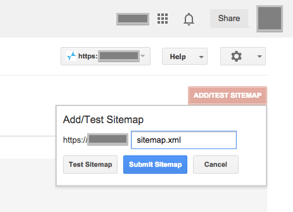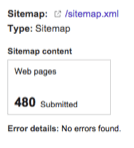If you’ve ever asked yourself “Why is our firm’s website not appearing in search engine results?”, one possible answer may be that you haven’t created an Extensible Markup Language (XML) sitemap for your website and submitted it to search engines via Google Webmaster Tools and Bing Webmaster Tools.
What is an XML Sitemap and Why is it Critical for Search Engine Optimization?
An XML sitemap is a file listing each individual page of your website to tell Google and other search engines about the organization of your site content. Search engine web crawlers like Googlebot read this file to more intelligently crawl your site.
XML sitemaps can provide valuable metadata associated with the pages in the sitemap. Metadata is information about a webpage, such as:
- When the page was last updated
- How often the page is changed
- The importance of the page relative to other pages in the site
View Hinge’s XML sitemap for an example.
Ideally, if your site’s pages are properly linked together, web crawlers can usually discover most of your site. But a sitemap is still a very helpful tool that can improve the crawling of your site and ensure web pages have the ability to appear in search results.
HTML Sitemaps are Not Enough for Effective SEO
You probably already have an HTML sitemap of all of your higher-level website pages and link to it from the footer of all of your site pages, similar to what we’ve done on the Hinge website:

Before XML sitemaps were invented, HTML sitemaps allowed search engines to crawl and index a variety of site URLs from any page on your site. While having HTML sitemaps are still a best practice to help visitors navigate your site, they are no longer the means by which search engines crawl and index websites.
Tools for Creating an XML Sitemap
Some content management systems (CMS), such as WordPress, have features that enable you to quickly and easily create an XML sitemap. A helpful free WordPress plugin is the All-In-One SEO pack that includes a feature to create an XML sitemap.
If you don’t have the functionality to generate a sitemap with your CMS, then you’ll need to create an XML sitemap. There are many XML sitemap generators. Some are free, but they often have a limit on the number of web pages it will include in the sitemap.
One easy to use and inexpensive tool is Sitemap Writer Pro.
While these tools enable you to submit your sitemap to search engines, they don’t enable you to see if the search engines can read your sitemap or if there are any errors in your web pages that prevent search engines from crawling them. For that information, you need to use Google Webmaster Tools and Bing Webmaster Tools to submit your sitemap. More on that below
SEE ALSO: 9 Essential Elements of an Effective Website Homepage for Professional Services Firms
Upload Your XML Sitemap to Your Website
Now that your XML sitemap is built, you need to upload the file to your website using the administrative control panel. When this is done, the URL for your XML sitemap should be similar to https://www.YourFirmName.com/sitemap.xml.
How to Submit Your XML Sitemap to Google via Google Webmaster Tools
Submitting your XML sitemap directly to Webmaster Tools accounts enables you to:
- Ensure search engines can read your sitemap
- See if there are any errors with web pages that require fixing in order to appear in search results
- Review what web pages you may be withholding from search engines by accident
If you do not currently have a free Google Webmaster Tools account, you’ll need to create one. Once you’ve created your account, follow these steps:
- Login to your Google Webmaster Tools account.
- In the left sidebar menu, click ‘Crawl’
- Click ‘Sitemaps’
- In the upper right corner of the page, click the red ‘ADD/TEST SITEMAP’ button.
- In the box that appears, type: sitemap.xml and click ‘Test Sitemap’ button. See image below:

- You should see a confirmation that the test is complete. Click ‘view test results’.
You should see the test results appear. If the correct number of web pages have been submitted and there are no errors, it is okay to submit the sitemap. If there are errors, there will be error messages telling you what the issues are. Correct the issues and re-test the sitemap.

- If the sitemap is okay to submit, click ‘Close sitemap test’ button.
- Back on the Sitemaps page, click the red ‘ADD/TEST SITEMAP’ button.
- In the box that appears, type: sitemap.xml and click the blue ‘Submit Sitemap’ button.
- Back on the Sitemaps page, you’ll see that the sitemap status is ‘pending’. It normally takes Google around 3-7 days to completely index all of the website pages. The amount of time depends on how many pages are in your website.
- Check back in your Google Webmaster Tools account periodically to view the progress. Once all of the pages are indexed, the date the sitemap was processed will appear instead of ‘pending’.
To submit your XML sitemap to Bing, create a Bing Webmaster Tools account and follow a similar process.
Continuous Monitoring of Webmaster Tools is Key
It’s important to monitor your Webmaster Tools accounts on a regular basis to ensure there are no errors or warnings that arise over time that prevent web pages in your sitemap from appearing in search results.
Give Your Website the Best Chance of Being Found in Search Engines
With organic search engine traffic often being the top driver of traffic to professional services firm websites, it’s critical to take a little bit of time to create and submit an XML sitemap to make sure each page of your website is able to appear in search engine results.
Learn more about increasing your firm’s SEO performance in our SEO Guide for Professional Services.
On Google+ or LinkedIn? Follow us +HingeMarketing and join us on LinkedIn.

